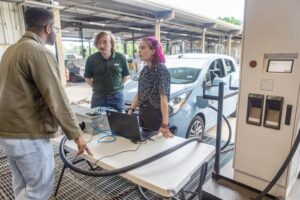Good Technology: Getting to grips with gizmos that promise us better air at home
 A range of tech solutions have been launched recently that promise to improve air quality in the home. For the latest issue of Air Quality News magazine, we investigated what those solutions are, and how much these promises stand up.
A range of tech solutions have been launched recently that promise to improve air quality in the home. For the latest issue of Air Quality News magazine, we investigated what those solutions are, and how much these promises stand up.
Gasp! Until recently, a lot of focus on air quality has been about the air outside – but more and more, people are thinking about what is happening in their own homes, and this is an area they feel they can, or should be able to, control. So what are they being offered and is the emerging smart tech as smart as it says it is?
Smart air conditioning (AC)
AC units tend to draw in air from a room, either heat it or cool it as required, then release it back into the room.
Smart versions of these systems offer all the advantages of traditional AC but can be operated remotely through a tablet or smartphone. Some models can even be connected to virtual assistants like Alexa, Google and Siri, enabling voice control.
Such smart AC systems can be scheduled to run at specific times, target temperatures can be set and fan speed adjusted. A key selling point of this kind of tech is that a smart AC system will slow or stop once the target has been reached, using less energy and so saving money on bills.
On the negative side, these kinds of AC systems can be bulky and intrusive. A unit installed in a window can block light and views. Although AC units can be mounted to walls or windows and come in several sizes, this can also cause problems. The temptation is to install smaller, less intrusive units but an AC system needs sufficient capacity for the room in which it works, as an over-exerted unit can pump dirty air back into the room!
Some, but not all, AC units can run quickly and quietly. Then there’s the issue of expected lifespan. Several smart AC units self-diagnose faults. This kind of tech is obviously more expensive but means the unit is easier to maintain and likely to last longer than conventional models. The tech is an investment.
Even so, smart AC can be expensive – both to buy the unit in the first place and then in energy costs to run, especially in large rooms.
Given all this, the Midea 8,000BTU U-shaped Air Conditioner has proved very popular. It’s a fast, quiet and relatively inexpensive system that’s easy to install and use, with voice control through Alexa and Google.
But note that AC systems don’t necessarily improve the quality of air in the room. To do that needs a more specific kind of tech…
Smart air purifiers
Air purification removes potentially harmful pollutants from the air, such as bacteria, dander from pets, pollen and volatile organic compounds. This is usually done by sucking air through a filter before releasing it again.
Smart versions of these systems often monitor air quality levels, providing useful data to the owner, and have automated functions that can make them more efficient. They can work in conjunction with other building management systems.
One impressive example is the sleek, lightweight Dyson Purifier Cool TP07, which includes a large fan and a magnetised remote control as well as app and voice control.
Purifiers such as this can remove invisible pollutants from the air. Yet often how clean the air feels – to breathe or against bare skin – is down to humidity.
Smart humidifiers and dehumidifiers
Humidity – the concentration of water vapour in the air – can cause all sorts of health problems if it’s either too low or too high. More seriously, ventilation and AC systems often control temperature but not humidity, the result being to encourage mould. Sadly, as some well publicised recent cases have made clear, spores from mould can present a serious hazard to health.
Systems that monitor and manage humidity can really help here. Most dehumidifiers work by drawing hot air over a low-temperature coil that causes water vapour to condense and drip down – as water – into a removable container.
Smart dehumidifiers can run automatically to maintain a target humidity and provide useful data on air quality, while being easy to operate. As with smart AC systems, the ideal model is quick-working but quiet but another major issue is the size of the tank used to collect water. Obviously, the bigger that is, the longer the dehumidifier can run.
The Telegraph recently judged the Midea Cube to be the best smart dehumidifier on the market. As well as its smart tech features, this stylish device can hold 11 litres of water, but when not in use collapses down for easy storage.
There are two basic types of humidifier for adding moisture to a room:
- Ultrasonic humidifiers use high-frequency sound waves to produce a fine mist that adds moisture to the air. These kinds of humidifier tend to be smaller, quieter to run and don’t need a filter – reducing the need for maintenance.
- Evaporative humidifiers aim a fan on a container of water to make it evaporate more quickly, producing humid mist. Such units tend to be bulkier, noisier and yet less expensive to buy than ultrasonic humidifiers.
The quick, quiet Levoit LV600S Smart Hybrid Ultrasonic Humidifier is a very popular model. The smart tech makes it easy to use, maintain and clean. It will even remind you when it needs cleaning.
These solutions are relatively large but some smart tech can be very small.
Smart sensors
These are a simpler, cheaper alternative to smart AC. The sensors let you know – by sounding an alarm or sending an alert to your phone – when there are high levels of airborne pollutants. You can then respond by, for example, opening a window.
A commonly used type detects carbon monoxide (CO), which is an otherwise colourless, odourless but deadly gas. The Google Nest Protect detector is a market-leading smart device that features an industrial-grade smoke and CO sensor that will last for up to a decade. App control means any alert can be silenced easily, without having to stand on a chair. The main issue here is that smart sensors only alert you to the issue; you then have to deal with it.
Smart ventilation
Ventilation is different from air conditioning in that it draws fresh air from outside into the building to replace the stale air inside. In cycling the air in this way, any pollutants, smells etc in the building are discarded. These systems are also good at eliminating condensation.
Smart ventilation systems can operate automatically – responsive to factors such as indoor or outdoor air quality, or the number of people in the building at one time. Again, they can provide valuable data on air quality.
For all their advantages, whole-building ventilation systems can be a sizeable investment and specialist advice should be sought.
That said, on the smaller scale there are several good, smart ventilation systems available for single-room use. For example, the Vent-Axia PureAir Sense Smart Bathroom Extractor Fan is a relatively quiet and fast-working unit with automated functions and app remote control.

















Leave a Reply